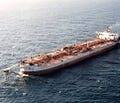FSO Safer: The rot sets in
When the war began in Yemen, the vessel really started to deteriorate.
War comes to Yemen
As previously detailed, by the late 1990s and early 2000s, the F.S.O. Safer was starting to show its age. Efforts to come up with a more permanent solution to what was always a temporary solution had initially stalled, until finally in 2012 work on an onshore terminal began.
But then in 2014, after the Houthi Shia rebel group took advantage of the weakness of the Yemeni President Abdrabbuh Mansour Hadi, who himself had taken over from previous President Ali Abdullah Saleh three years earlier after the Arab Spring, war came to Yemen. The Houthis took control of the northwest of Yemen - and eventually the capital Sanaa (with Hadi fleeing the country into exile) - including Yemen’s main port on the Red Sea, Hodeidah, and the Ras Isa Marine Terminal where the Safer was moored. (The next year was when the conflict escalated even further when Saudi Arabia et al got directly involved.)
Skeleton crew, no money, no maintenance
Like anything mechanical and big - and old - the Safer needed to be constantly inspected and maintained to keep it functioning even adequately. It may have passed some official inspections when there was enough budget, personnel and regional stability, but the moment this was no longer possible things really started to deteriorate.
As the name implies, an F.S.O. or Floating Storage and Offloading unit, is not used to transport oil but rather as a way of temporarily storing oil until it can be offloaded onto another vessel for transport. (You can have also an F.P.S.O. - or Floating Production Storage and Offloading unit.)
When the structure of such a vessel begins to deteriorate, and you are carrying a potential flammable cargo of oil on board, then issues can magnify when maintenance capabilities dry up.
As it stands right now, the Safer is most vulnerable to the following:
A corroding steel hull, pipes and valves from prolonged sea exposure.
Its one million barrels of oil, stored in 34 different tanks, mixed up with a swirling array of gases, that could lead to a huge explosion if coming into contact with a spark or stray cigarette butt.
Things fall apart: a brief timeline
Drawing again on Ed Caesar’s detailed and excellent account of the Safer from the New Yorker, here is an overview of how things began to crumble:
With the Houthis on the scene, the Safer continued to be operated by SEPOC, but the Yemeni state oil company had its overall $110 million annual budget appropriated, with the $20 million set aside for the Safer reduced to nothing.
By 2015, all expatriates except one working on the Safer had left, along with the presence of the usual array of supporting boats and divers; local workers were now transported to and from the Safer by local fishing boats.
In 2017, after a period of rationed usage, the Safer ran out of fuel to power its steam boiler, which in turn powers much of the ship, including its fire safety systems and the essential function of “inerting” to avoid the whole thing blowing up. (Inerting involves injecting inert gases into where the oil is stored to neutralise any emanating flammable hydrocarbons.) They considered using the ships’ own oil as a source of power, but averred due to the dangers associated with those gases rising from the oil. Two diesel generators now operate on board, but are mainly used for things like charging up laptops and other basic functions for the crew.
2017 also saw SEPOC, already in financial trouble with a United Arab Emirates engineering firm for the now abandoned onshore terminal project, try and sell the Safer for the tad ambitious price tag of $60 million.
Circa 2018, the only crew left consisted of a chief engineer, an electrician, two mechanics, a cook, and a cleaner; they tried to rotate them out every month or so, external war conditions permitting, of course. Sensing the danger of the Safer being hit by any munitions, SEPOC went ahead and filled the outside tanks with seawater as some kind of buffer for the oil stored in tanks running down the middle.
In May 2020, the Safer nearly sank when a corroded pipe, linked to an external valve used for pumping seawater throughout the ship for cooling purposes (before being expelled), was found leaking seawater into the engine room. The crew worked for five days to try and stop the inflow, as well as also pump the water out of the engine room. An external team of divers - with no experience of oil tankers - managed to eventually fashion a steel plate over the external valve positioned underwater. This seems to be a temporary fix though and water still leaks in, having to be pumped out using the generators on board. After the incident, gun-toting Houthi soldiers began to come on board, including to install surveillance cameras.
Later in 2020, the United Nations stepped in and tried to buy a little insurance by purchasing a one kilometre length self-inflating “oil boom” from NorLense, a Norwegian oil spill-response company firm, which if required basically could wrap around the Safer in the surrounding sea and start to absorb any spilled oil.
But insurance is only that, and does not replace the need to actually get the oil off the Safer and onto a more secure vessel. In the next instalment, I will cover what the United Nations had been trying to do in that direction, if they could get the Houthis to co-operate.
.



